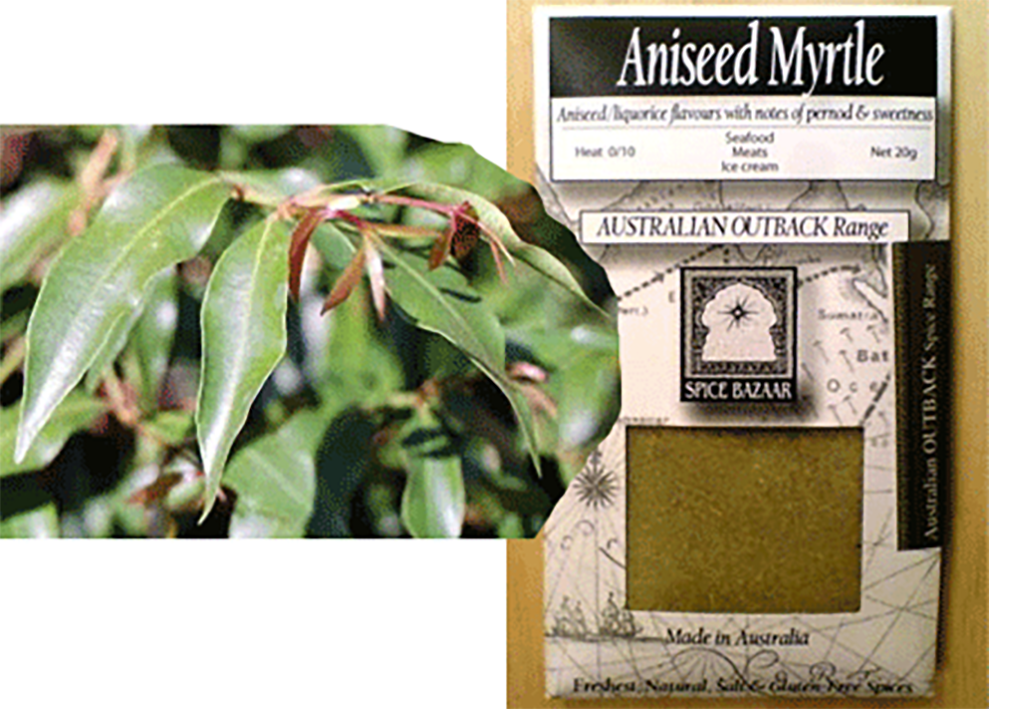 The leaves and
commercially sold
powdered dried
leaves of Aniseed
Myrtle, Syzygium
anisatum.
The leaves and
commercially sold
powdered dried
leaves of Aniseed
Myrtle, Syzygium
anisatum.
Welcome to the summary page for FabulousFusionFood's Herb guide to Aniseed Myrtle along with all the Aniseed Myrtle containing recipes presented on this site, with 0 recipes in total.
e This is a continuation of an entire series of pages that will, I hope, allow my visitors to better navigate this site. As well as displaying recipes by name, country and region of origin I am now planning a whole series of pages where recipes can be located by meal type and main ingredient. This page gives a listing of all the Cornish recipes added to this site.
These recipes, all contain Aniseed Myrtle as a major herb flavouring.
Aniseed Myrtle, Syzygium anisatum (formerly known as Backhousia anisata and Anetholea anisata and also known as anise myrtle, aniseed tree or ringwood) is a native Australian rainforest tree of the Myrtaceae (myrtle) family.
The anise myrtle tree has a dense crown and grows up to 45 metres. The leaves are 6—12 cm long with prominently wavy margins and a strong aniseed aroma. Flowers are white and sweetly scented, borne in panicles. The fruit are dry papery capsules some 5 mm long. Anise myrtle's natural distribution in the wild is restricted to the Nambucca and Bellinger Valleys in the subtropics of Eastern Australia (specifically New South Wales).
The leaves of aniseed myrtle are very aromatic and they have a flavour and aroma profile very similar to true aniseed. As a result the trees have been grown commercially since the 1990s for their essential oils, which are used in making perfumes. The flavour profile of the leaves has also made them popular for aficionados of 'bush food' and dried aniseed myrtle leaves are now sold both as an herb for flavouring and for making teas.
Commercial aniseed myrtle is grown in plantations to meet the demand for this plant. The essential oil of the leaves contains anethole and methyl chavicol (which impart aniseed and liquoirce flavours, respectively). The high concentration of trans-anethole in the leaves makes them valuable as a bushfood spice.
e This is a continuation of an entire series of pages that will, I hope, allow my visitors to better navigate this site. As well as displaying recipes by name, country and region of origin I am now planning a whole series of pages where recipes can be located by meal type and main ingredient. This page gives a listing of all the Cornish recipes added to this site.
These recipes, all contain Aniseed Myrtle as a major herb flavouring.
Aniseed Myrtle, Syzygium anisatum (formerly known as Backhousia anisata and Anetholea anisata and also known as anise myrtle, aniseed tree or ringwood) is a native Australian rainforest tree of the Myrtaceae (myrtle) family.
The anise myrtle tree has a dense crown and grows up to 45 metres. The leaves are 6—12 cm long with prominently wavy margins and a strong aniseed aroma. Flowers are white and sweetly scented, borne in panicles. The fruit are dry papery capsules some 5 mm long. Anise myrtle's natural distribution in the wild is restricted to the Nambucca and Bellinger Valleys in the subtropics of Eastern Australia (specifically New South Wales).
The leaves of aniseed myrtle are very aromatic and they have a flavour and aroma profile very similar to true aniseed. As a result the trees have been grown commercially since the 1990s for their essential oils, which are used in making perfumes. The flavour profile of the leaves has also made them popular for aficionados of 'bush food' and dried aniseed myrtle leaves are now sold both as an herb for flavouring and for making teas.
Commercial aniseed myrtle is grown in plantations to meet the demand for this plant. The essential oil of the leaves contains anethole and methyl chavicol (which impart aniseed and liquoirce flavours, respectively). The high concentration of trans-anethole in the leaves makes them valuable as a bushfood spice.
The alphabetical list of all Aniseed Myrtle recipes on this site follows, (limited to 100 recipes per page). There are 0 recipes in total:
Page 1 of 1
Page 1 of 1